In Rome, one of Michelangelo Buonarroti’s best-known sculptural creations is housed inside the Basilica of St. Peter in Vincoli, to which the evocative Borgia climb leads from Via Cavour: the Moses.
The artist began work on the statue during the second decade of the 16th century to place it in the monumental complex that was to house the burial of Pope Julius II, who died in 1513.
However, the entire initial design for what was supposed to be an imposing mausoleum inspired by the great Roman sepulchral buildings, adorned with more than forty statues, underwent continuous revisions during the four decades it took Michelangelo to finish the work, revisions that essentially resulted in the progressive reduction of the monument’s dimensions.
The affair, which Ascanio Condivi in his biography of the artist called with the famous words “the tragedy of the burial,” began in 1505, when Michelangelo was summoned to Rome by the Pontiff della Rovere, with whom he entered into an agreement for the realization of the aforementioned tomb. But the situation quickly changed. The two came into conflict, and when they reconciled Buonarroti was asked to leave out the burial to devote himself to the pictorial decoration of the Sistine Chapel ceiling. Close to the conclusion of that immense undertaking Julius II died, so that negotiations were carried on by Michelangelo with the late pope’s heirs, not without frequent and resounding quarrels. The contract as it had been stipulated with Julius II, in fact, was never fulfilled and was replaced by numerous other agreements that saw, from time to time, the time frame lengthened and the scope of the tomb and the number of statues that were to adorn it diminished.
The monument’s location, too, changed as the years went by: according to what was planned in the first phase, in fact, it was to be placed in the choir of the Vatican Basilica, and only later, in 1532, was it decided that its final location would be in San Pietro in Vincoli, a basilica that of Giuliano Della Rovere (the future Julius II) had been a cardinal’s title.
Moses can be seen today in the central niche of the lower order of the mausoleum, where it was placed in the mid-1540s, flanked by the statues Rachel and Leah, personifications of Contemplative Life and Active Life, respectively, while above them find their place, from left to right, a Sibyl, the late pope lying on a sarcophagus at the foot of a Madonna and Child, and a Prophet. Of the latter four works, only the statue of Julius II is entirely attributable to Michelangelo, while the others are largely the work of Raffaello da Montelupo.
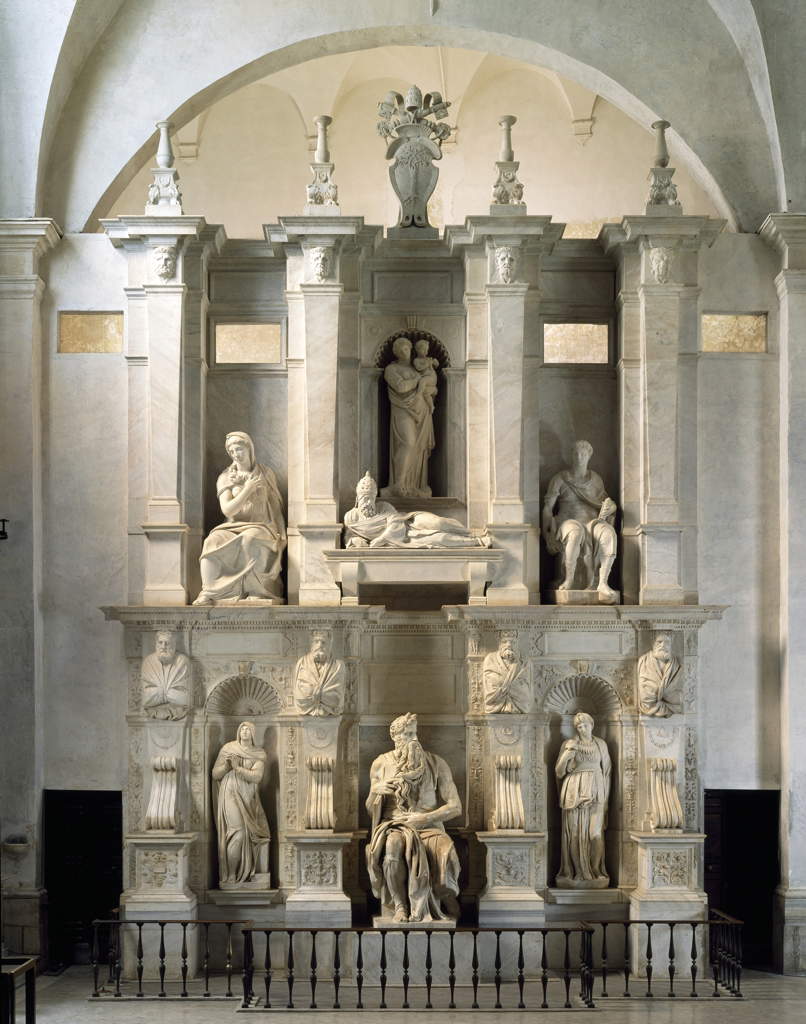 |
| Michelangelo Buonarroti, Tomb of Julius II (1505-1545; marble; Rome, San Pietro in Vincoli). Ph. Credit Andrea Jemolo |
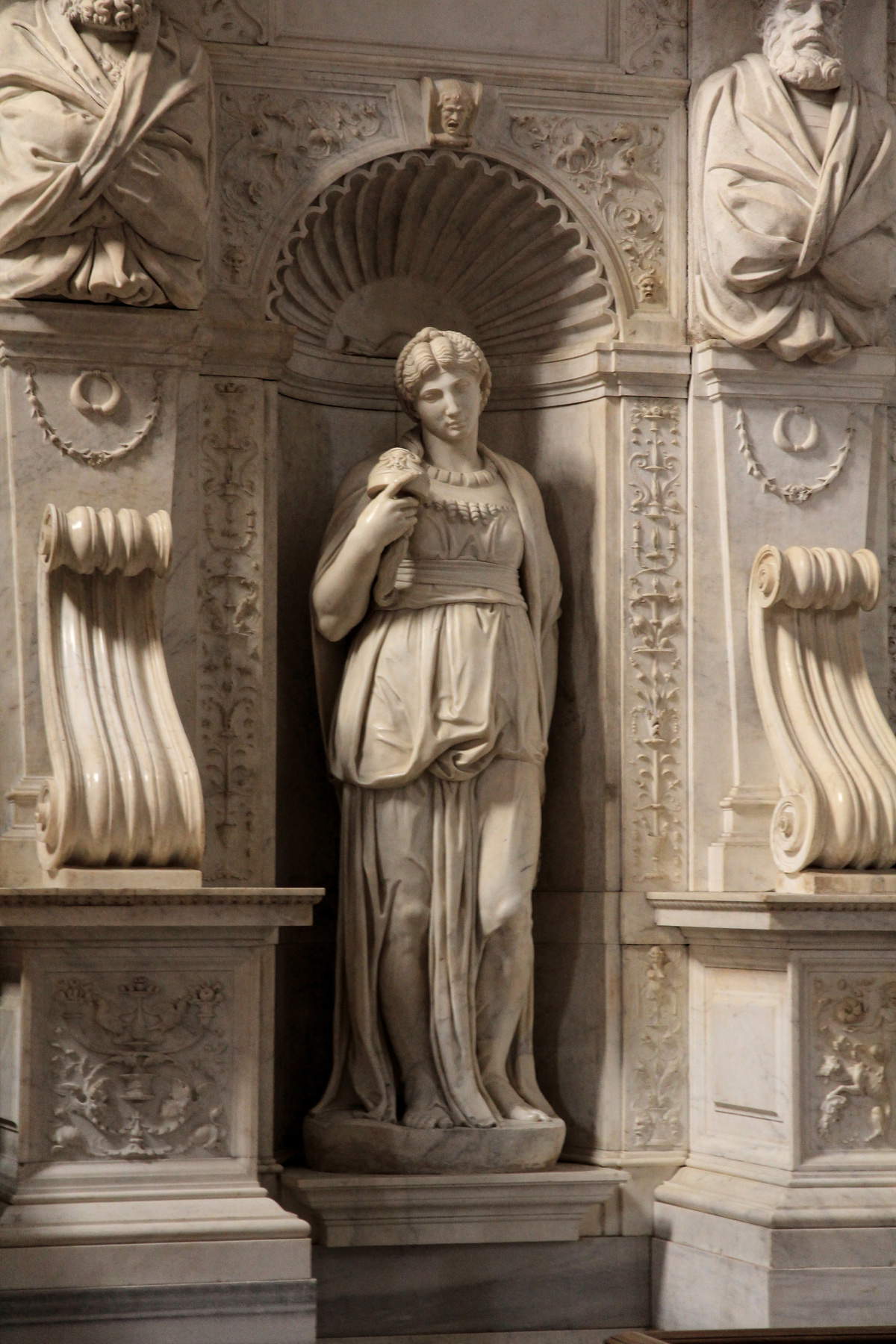 |
| Michelangelo Buonarroti, Lia (c. 1542; marble, height 197 cm; Rome, San Pietro in Vincoli). Ph. Credit Jörg Bittner Unna |
 |
| Michelangelo Buonarroti, Rachel (c. 1542; marble, height 209 cm; Rome, San Pietro in Vincoli). Ph. Credit Jörg Bittner Unna |
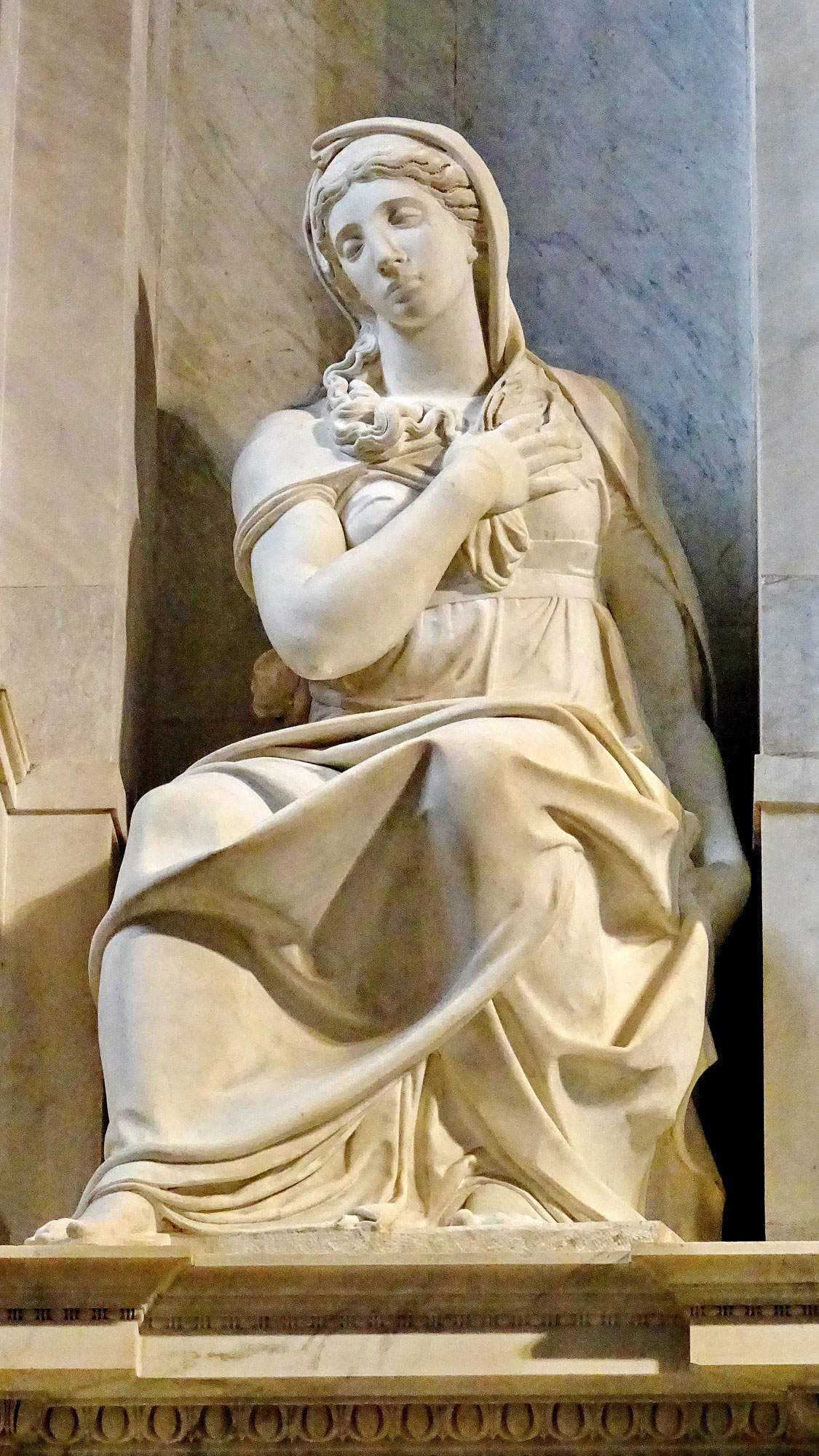 |
| Raphael of Montelupo, Sibyl (1537-1545; marble; Rome, San Pietro in Vincoli). Ph. Credit Luciano Tronati |
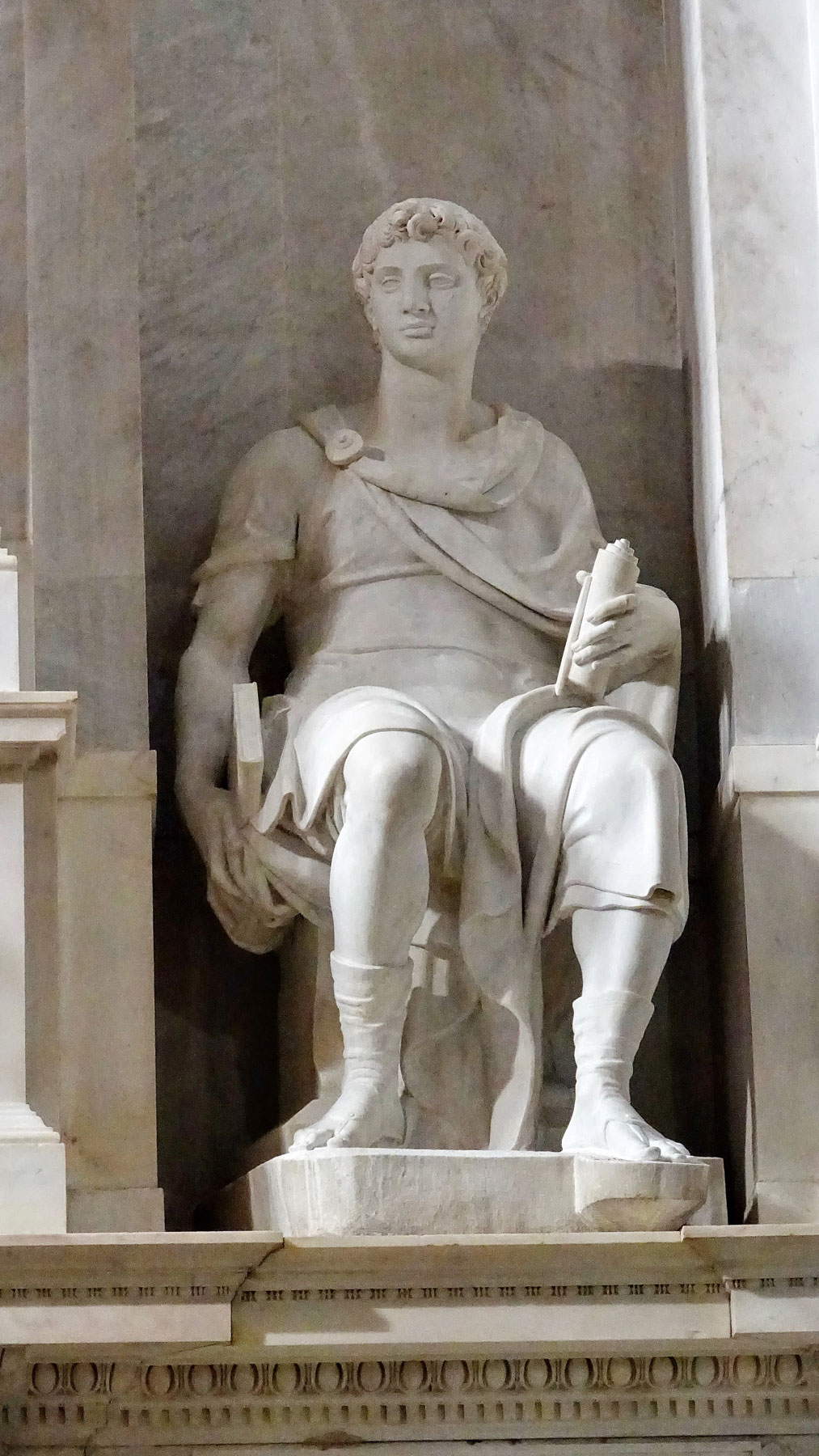 |
| Raffaello da Montelupo, Prophet (1537-1545; marble; Rome, San Pietro in Vincoli). Ph. Credit Luciano Tronati |
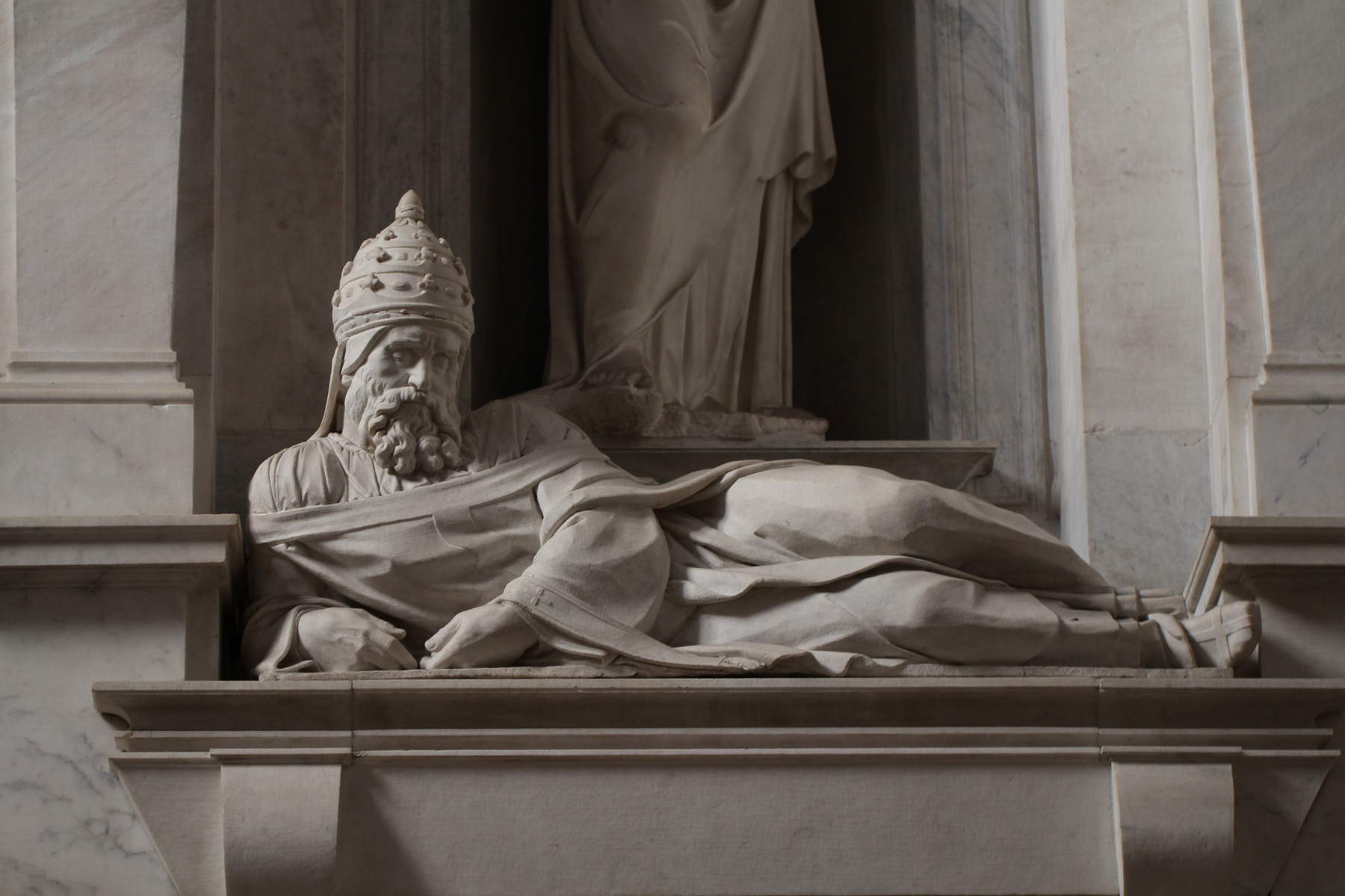 |
| Michelangelo Buonarroti (attributed), Julius II (c. 1542; marble; Rome, San Pietro in Vincoli). Ph. Credit Jörg Bittner Unna |
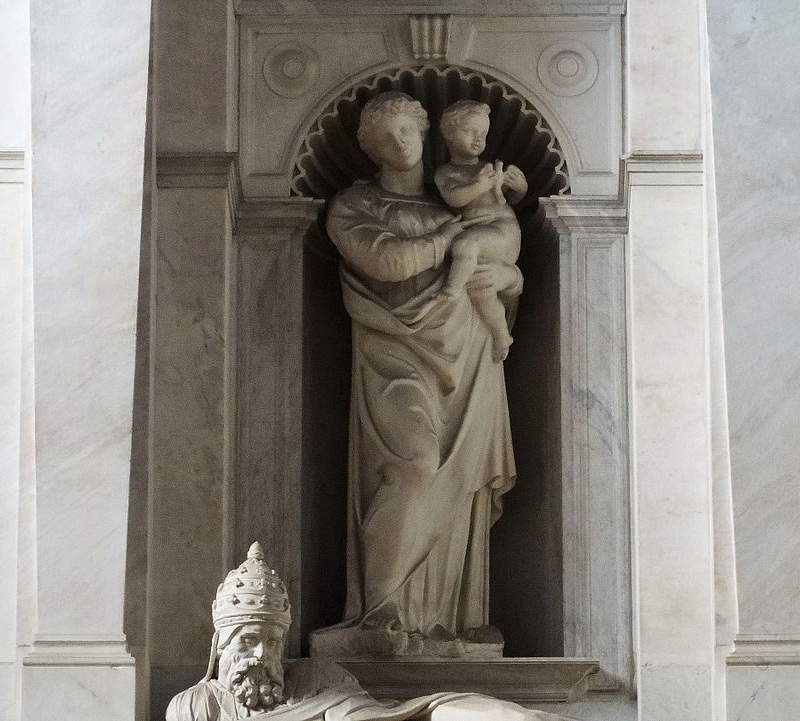 |
| Raffaello da Montelupo, Madonna and Child (1537-1545; marble; Rome, San Pietro in Vincoli). Ph. Credit Luciano Tronati |
The sculpture depicting the Jewish head stands out from the others in power and size: it towers in the center of the monument with the same vigor that characterizes the Prophets, painted shortly before by Buonarroti on the vault of the Sistine Chapel. Everything about this marble portrait communicates tension and dynamism: a leg bent back, as if Moses is about to stand up, the powerful musculature of the uncovered arms, the face turned in a posture that, the intensity of the facial expression accomplice, appears to be the consequence of a motion of disquiet.
The vivid realism that characterizes the statue and the inner strength that emanates from it are, probably together with Michelangelo’s well-known stormy character, at the origin of the famous as well as unfounded anecdote according to which the artist, also stunned by the vitality of his Moses, turned to him and asked, “Why don’t you speak?” and then hit him with a hammer on one knee having received no answer. On the other hand, there is nothing easier than for fanciful legends to arise around a famous work, and the famous Moses was, and is, definitely very famous.
Testimony in a far different tenor to the fascination that the imposing figure has held over the centuries is the well-known 1914 text, Michelangelo’s Moses, which Sigmund Freud dedicated to the sculpture, having it published in the magazine Imago initially anonymously. This was not the first time that the father of psychoanalytic theory had taken an interest in the art world; in fact, four years earlier he had already published an essay in which he delved into some aspects of Leonardo da Vinci ’s personality from a childhood memory jotted down by the Tuscan master. However, in the 1914 paper Freud focused on a work, rather than an individual, going so far as to formulate a reconstructive hypothesis of the psychological and physical motions of the marble Moses prior to the moment in which he was seized by Buonarroti’s chisel, and by virtue of which the statue would appear to us with the posture and expression we still see today. What Freud did, then, was to observe the statue as he would have done with a living being, with a patient whose emotional process is to be reconstructed. This was a procedure that, as Cesare Musatti observed in a 1980 essay devoted to Freud’s relationship with his religion of origin, Judaism, risked exposing both the author and the young psychoanalytic practice itself to criticism from art scholars, and it was precisely this, according to Musatti, that was the reason why Freud at first decided to publish his text anonymously.
Instead, what prompted him to undertake such work had been, as he himself writes at the beginning of the essay, his enormous admiration for the statue, which had led him, during a stay in Rome, to return several times in front of the marble that appeared impenetrable to him.
Of course, even before the Austrian doctor, many art historians and critics had already commented on the peculiarities of Michelangelo’s sculpture: the head turned to the left, the marked bending of one leg, an index finger curiously sunk into the splendid beard, the tablets of the law squeezed between one arm and the side but resting on the edges, are all details that have always attracted the attention of experts (and others). And in his analysis Freud does not ignore their considerations at all; in fact, he starts from there. Many of the authors he cites, including Anton Springer, Jacob Burckahrdt, and Carl Justi, had come to the conclusion that Michelangelo had chosen to freeze exactly the moment when Moses, having just descended from Sinai, surprises his people in the act of worshipping the golden calf and becomes agitated, nervously grasping his beard, a second before leaping to his feet in anger. In theOld Testament we read that shortly thereafter the man loses control completely, offended by the impiety of his people, and hurls the tables to the ground, destroying them.
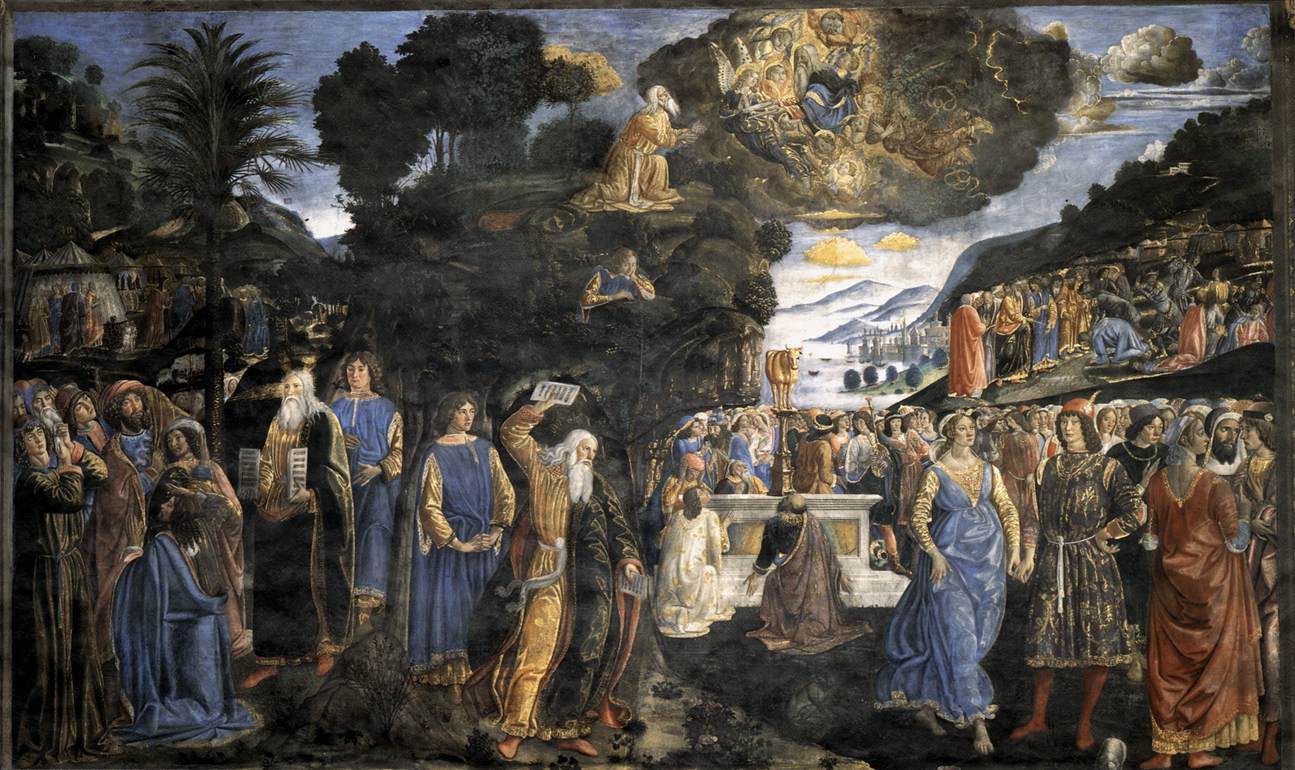 |
| Cosimo Rosselli, The Tables of the Law and the Golden Calf (1481-1482; fresco, 350 x 572 cm; Vatican City, Sistine Chapel) |
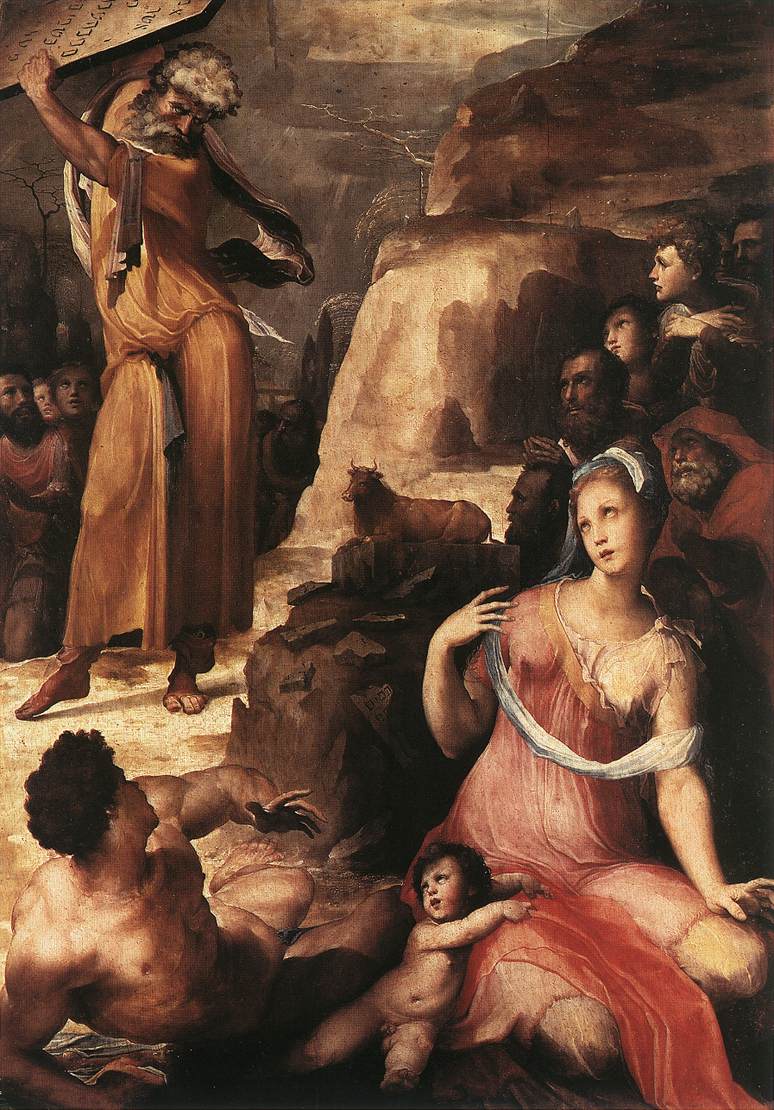 |
| Domenico Beccafumi, Moses and the Golden Calf (1536-1537; oil on panel, 197 x 139 cm; Pisa, Duomo) |
However, although Freud agrees on the identification of the moment immortalized by Michelangelo, the one in which Moses discovers the betrayal of his people, he believes that the character created by the Florentine artist, unlike the biblical one, is restraining himself, calming his anger and coming to his senses.
At the time the Austrian scholar was writing it was believed that the statue was finished around 1515 (or at any rate before the 1517 trip to Florence) as it is observed today, a belief that, as we shall see, has recently been refuted. Thus, since the design of the monument that had been agreed upon with the patrons in those years called for Moses to be flanked by three other statues, all depicting seated figures, Freud judges it unlikely that only one sculpture had been executed to suggest, instead, the idea of a sudden motion, which would have risked appearing awkward and out of place in that context. In fact, he writes: “If the other figures were not also depicted on the verge of turning to violent action (and this seems very unlikely) a very bad impression would have been created if one of them had given us the illusion that he was about to abandon his place and his companions, that is, to abandon his role in the general scheme. (...) A figure in the act of hastily walking away would be in complete discordance with the state of mind the tomb wants to suggest in us.”
From this conviction the author starts to formulate his hypothesis.
Putting aside the idea that the Moses was conceived by the Florentine artist as a type-character in which to concentrate all the spiritual force of an ideal leader, previously expressed by art historian Henry Thode in his Michelangelo and the End of the Renaissance (vol. III), because it was deemed unable to clarify the tension and contradictions that characterize the figure, Freud focuses on details, two in particular: the position of the panels and that of the right hand resting on them. Noting that only the right index finger is pressed rather unusually into the beard, while the other fingers barely graze the soft mass, and concluding therefore that one cannot dismiss this gesture as the act of nervously playing with one’s beard before indulging in wrath, as authors had done before, Freud speculates that Michelangelo depicted a moment of transition, and in particular one in which Moses is retracting his left arm and hand and thus loosening his grip on the beard. The scholar imagines the succession of a series of movements, which he also has reproduced in four drawings as support for the reader, and which would have led Moses to the exact posture in which Michelangelo portrayed him.
In his view, the figure who dominates the tomb of Julius II was, yes, on the verge of raging against the idolaters, but at the height of his fury he turned his own rancor against himself, grasping his beard with his right hand with which he previously held the initially upright Tablets, which then slid forward and risked falling. It was at this point that the man decided to control himself, withdrawing his right arm to press it against them, now left to rest on the edges, and save them. This would have caused the hand to also be retracted and, involved in this movement, the index finger would drag behind part of the beard in which it had sunk. What we see, then, would be only the remnant of a powerful temper tantrum, now tamed; the scornful look remains, the still bent leg of the man about to rise, and the Tablets in the strange position they have assumed. Moses has regained control and will not sprint to his feet in a rage: he will remain, albeit with all the disdain with which his gaze seems charged, surveying the tomb of Julius II, eternally fixed in a calm that still drips with tension.
According to this reading, Michelangelo would have taken considerable liberty, recounting a man quite different from the one described in the Bible, who, on the contrary, indulges his wrath to the hilt and destroys God’s precious gift. Particularly interesting is the way in which Freud argues his thesis: the virtuous conduct adopted by the Moses birthed by Michelangelo’s imagination, would have been intended to serve as a rebuke to the late Julius II and as a warning to the artist himself, who shared the impetuous character with the pontiff.
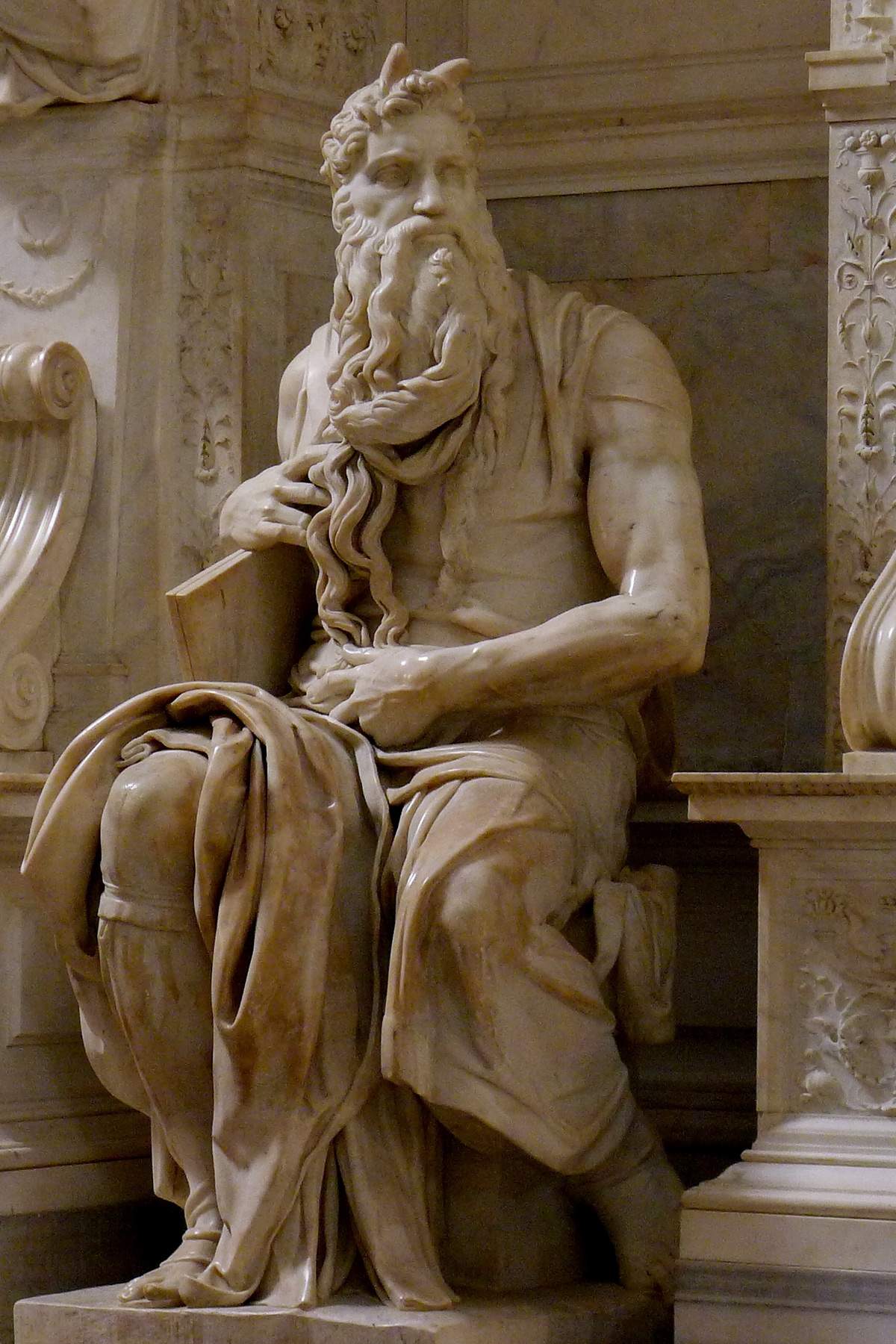 |
| Michelangelo Buonarroti, Moses (1513-1515; marble, height 235 cm; Rome, San Pietro in Vincoli). Ph. Credit Jörg Bittner Unna |
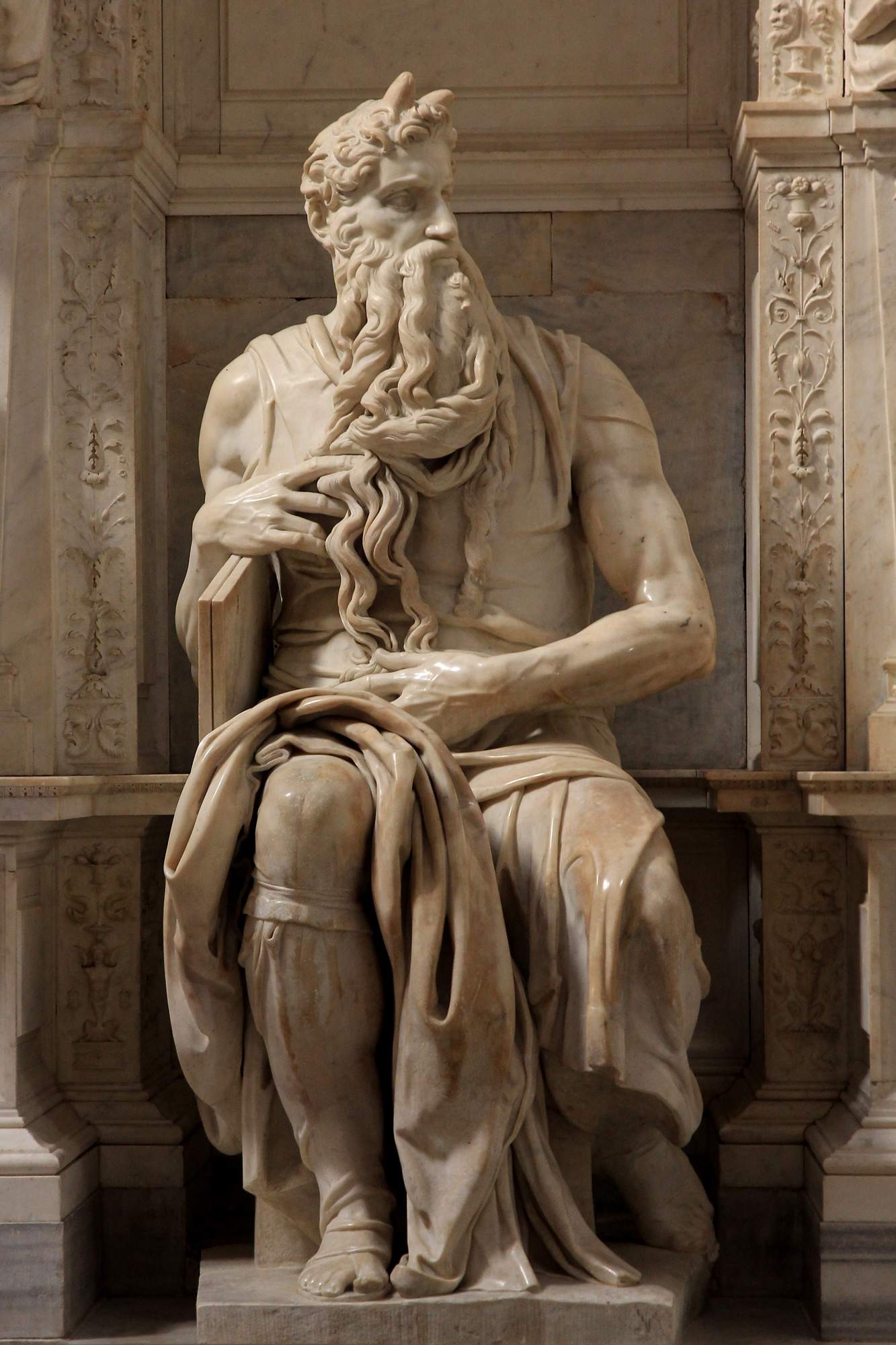 |
| Michelangelo Buonarroti, Moses (1513-1515; marble, height 235 cm; Rome, San Pietro in Vincoli). Ph. Credit Jörg Bittner Unna |
Already the aforementioned Thode had proposed a connection between the demeanor of the marble Moses and the personalities of Julius and Michelangelo, although it should be remembered that his interpretation of the work differed from Freud’s. The art historian, as mentioned above, considered the statue of St. Peter in Chains not a historical figure, but rather the “personification of an inexhaustible inner force taming the recalcitrant world,” in which the sculptor’s emotional experiences and his impressions of the temperament of the pope whose tomb he was working on took shape.
A further and much later interpretation worth mentioning, however, is that of the relationship between the sculpture and the Austrian doctor himself, which was argued by Ernst H. J. Gombrich, in his celebrated Freud and the Psychology of Art. Gombrich, taking up what Freud’s biographer Ernst Jones had already suggested, argued that underlying the psychoanalyst’s reading of the statue was his identification with the figure of the liberator of the Jewish people. Like Moses, in fact, Freud had faced a burning disappointment at the very time he was writing the essay; those were the years of the break with Jung and the disagreements within the Psychoanalytic Society, because of which, Gombrich writes that Freud “identified himself with Moses who, having come down from the mountain, had found his people dancing around the golden calf.”
But returning to our essay, Freud concludes with a consideration of the inevitable relationship that arises between the work of the artist and that of the interpreter, and examining the insights of another author, Watkiss Lloyd, who had grappled shortly before him with the same theme coming to similar conclusions, he writes: “What if we both went down the wrong road? (...) What if we, too, have fallen victim to the same fate as so many interpreters, who believe that they see sharply things that the artist did not intend to create either consciously or unconsciously? These are questions I cannot answer. I cannot say whether it is possible to attribute to an artist like Michelangelo -in whose works he struggles to express himself such a rich content of thought- such naive indeterminacy (...). Finally, we can still add in all modesty that the artist shares with the interpreter the responsibility for this uncertainty.”
A century later, it is possible to say that Freud’s considerations were generally not accepted by art historians; moreover, new conjectures, the result of a study conducted from a recent restoration, lead us to imagine, today, a completely different scenario from the one evoked by our author.
In fact, restorer Antonio Forcellino, while he was busy working on Michelangelo’s work in the early 2000s, decided to delve into the testimony of a friend of the Tuscan sculptor who in 1564 had told Vasari, in a letter published as early as 1930 by art historian Karl Frey but later ignored by critics, how the artist had turned the head of the Moses, initially made with a frontal position. Here is a portion of the text: “Hauendo lui fece drizzare in piede in his house the statue of Moise, quale era bozzata assai a buon termine infino al tempo di papa Julio Secondo, trouandomi io seco a guardarearla, I said to him: ’If this figure stood with its head uolta in qua, chredo, che forse fare megglio’. He did not answer me to this; but two days later, being with him, he said to me: ’Don’t you know, Moise intended to speak to us the other day, and in order to understand each other better, he spoke to me. Et andando io a uedere, trouai che li haueua suoltato la testa et sopra la punta del naso gli haueua lasciato un poco della gota con la pelle uecchia”.
According to Forcellino, this modification would have been made in 1542, just a few years after the statue was put in place, and would now make it possible to explain the many details already discussed at length, and not only those, opening the way to an entirely new reading of Moses and the creative process from which he sprang. In the text Michelangelo. An Unquiet Life compiled by the restorer in 2007 we read, "When he resumed sculpting the Moses, Michelangelo wanted to change its posture, despite its advanced state of workmanship. This extraordinary technical gamble left many traces on the statue and even a document, which went unnoticed until the sculpture’s material anomalies, which became apparent during its restoration, demanded a well-founded explanation."
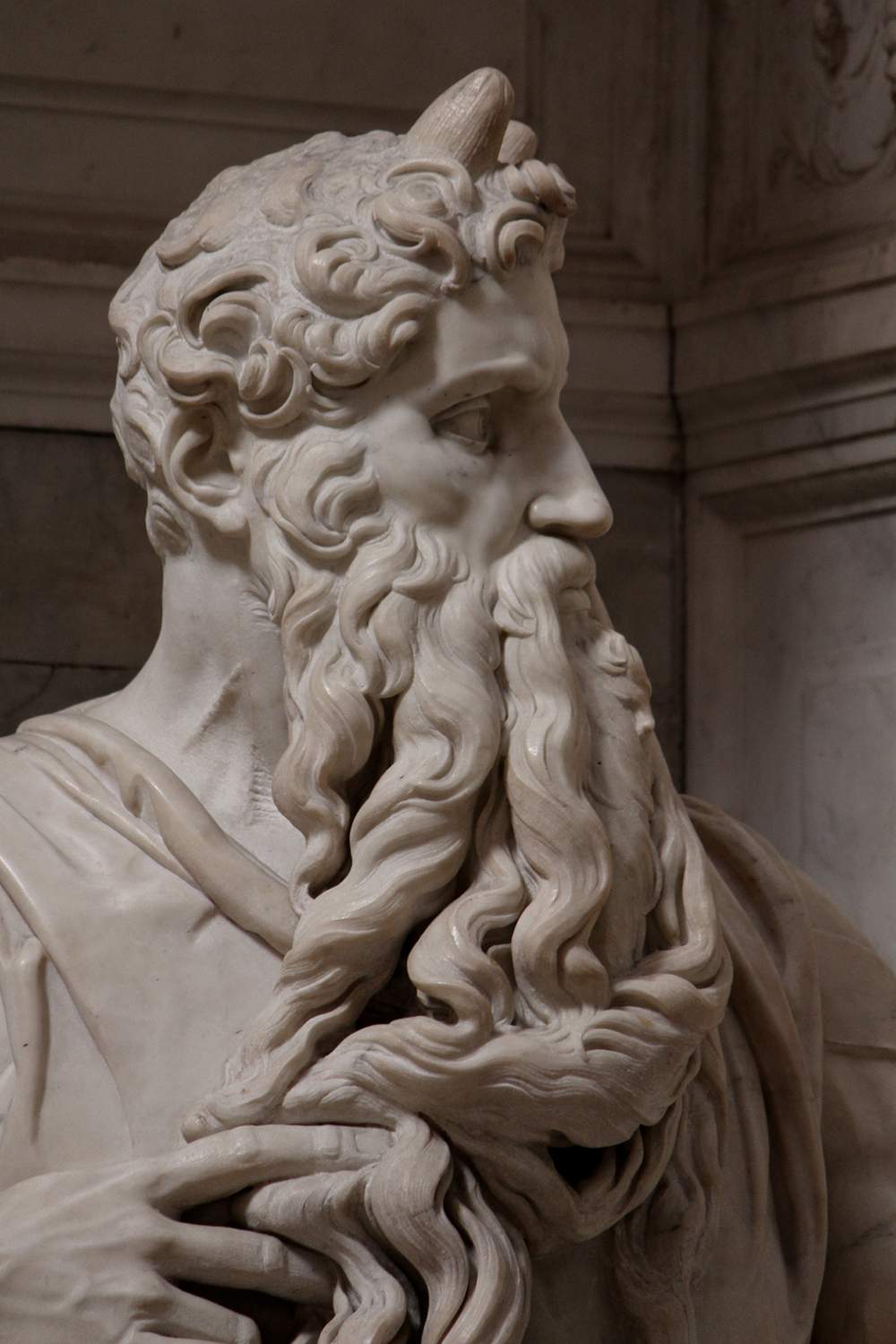 |
| Michelangelo Buonarroti, Moses, detail of the neck. Ph. Credit Jörg Bittner Unna |
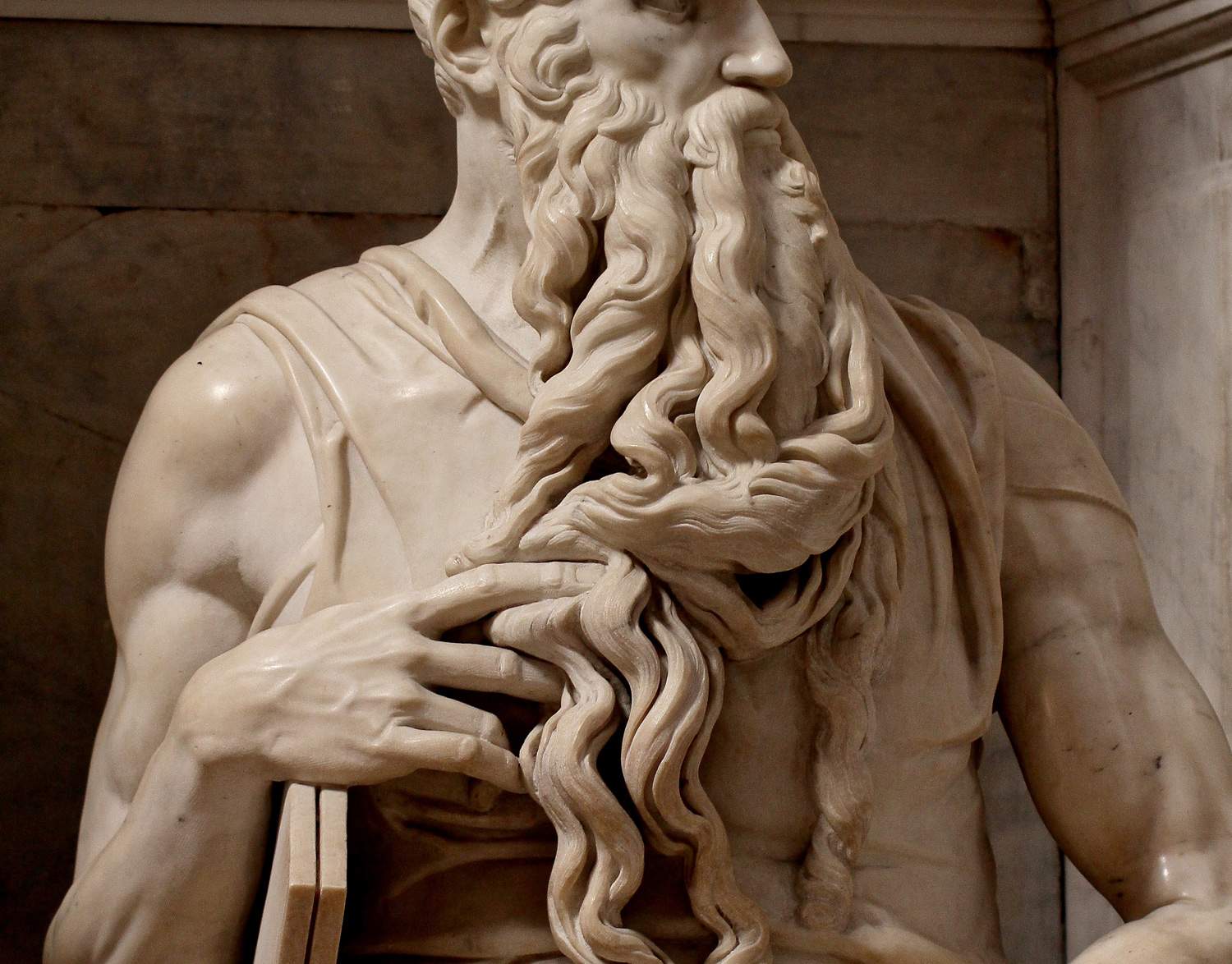 |
| Michelangelo Buonarroti, Moses, detail of the beard. Ph. Credit Jörg Bittner Unna |
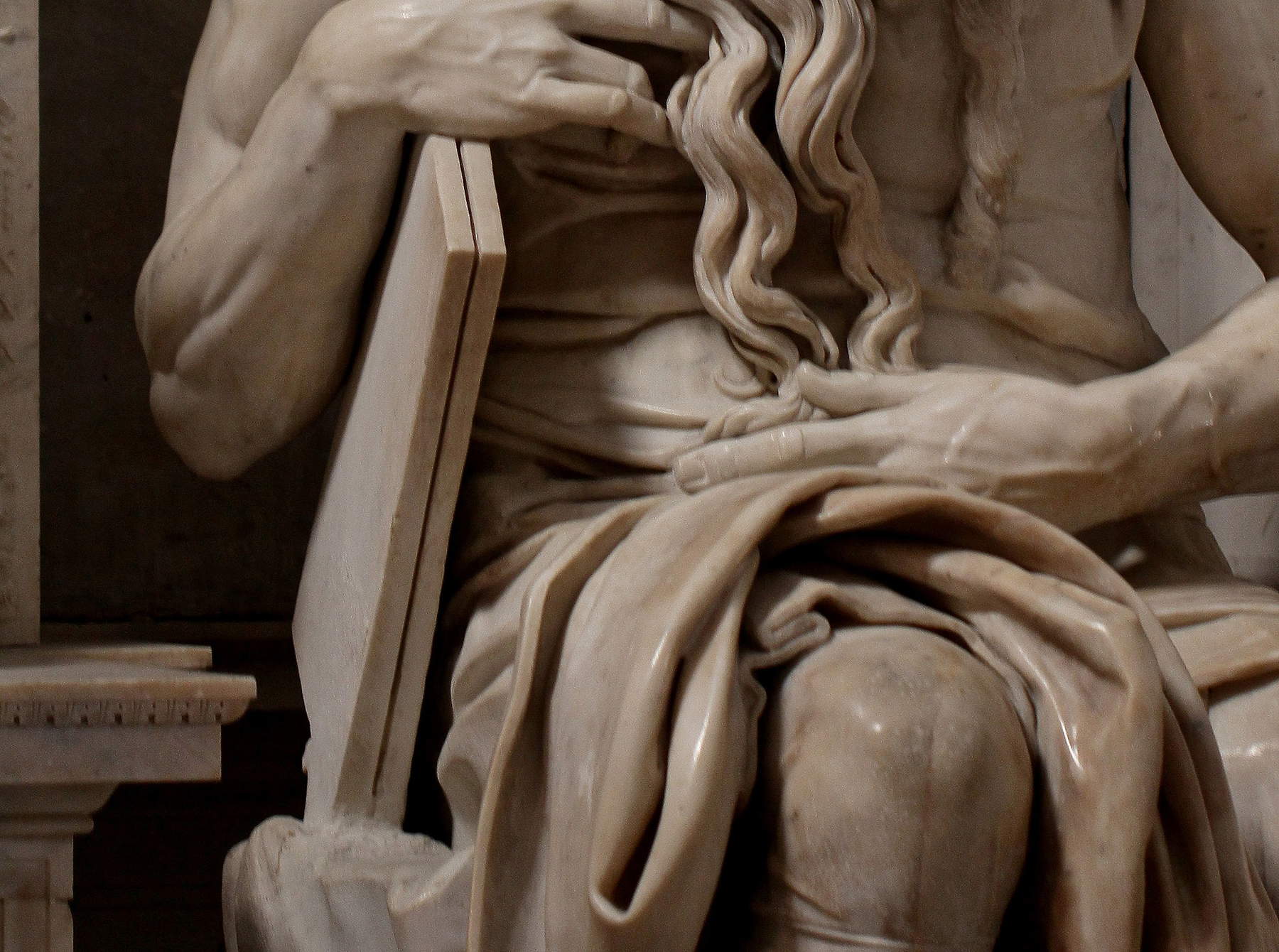 |
| Michelangelo Buonarroti, Moses, detail of the boards. Ph. Credit Jörg Bittner Unna |
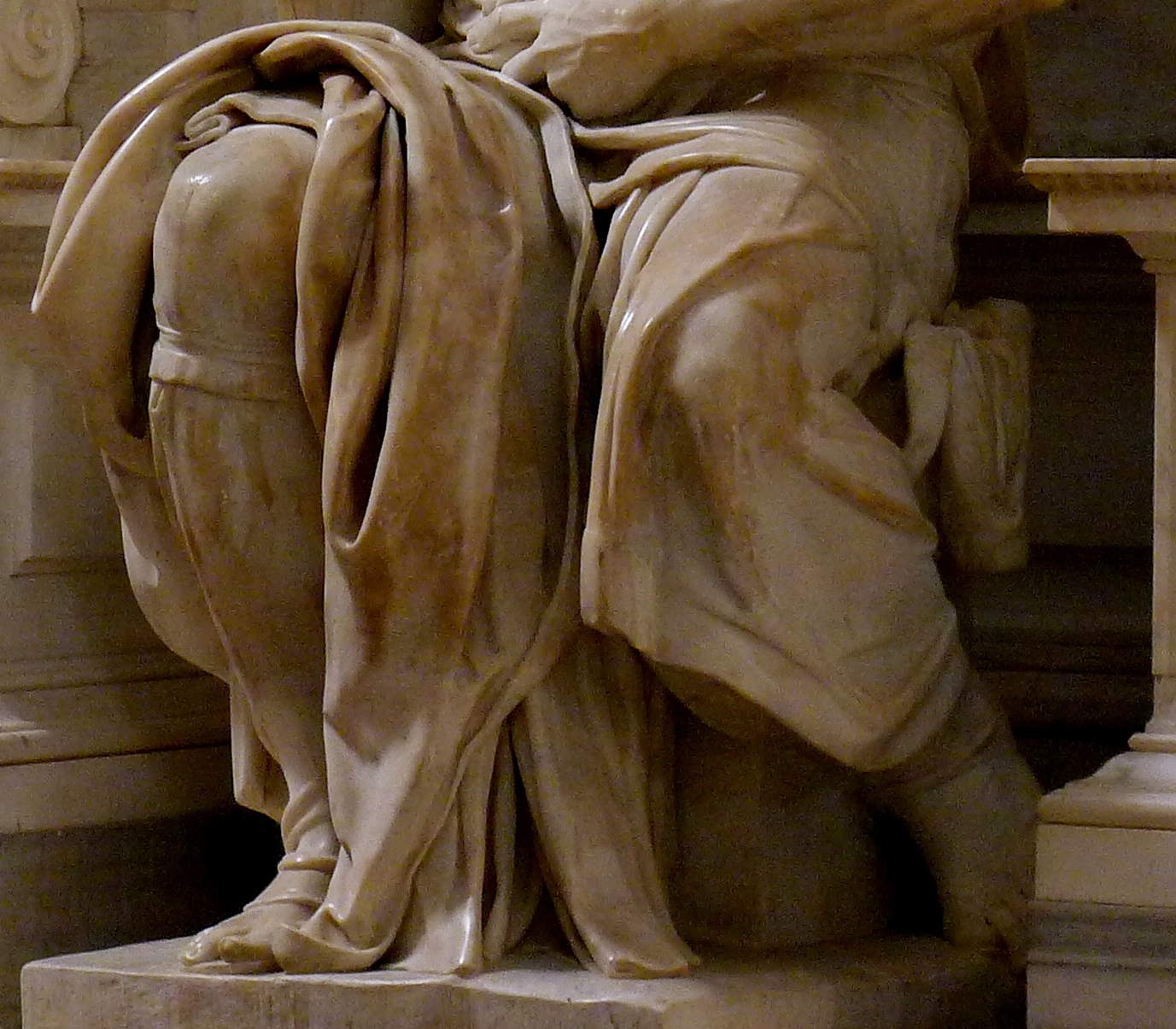 |
| Michelangelo Buonarroti, Moses, detail of the legs. Ph. Credit Jörg Bittner Unna |
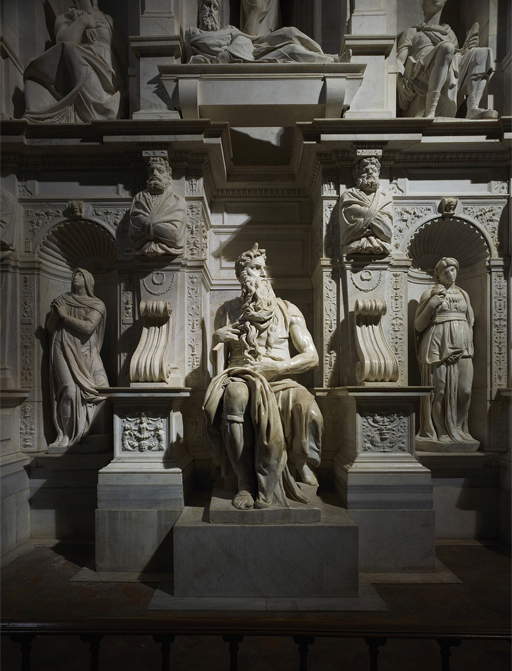 |
| Moses illuminated by Mario Nanni |
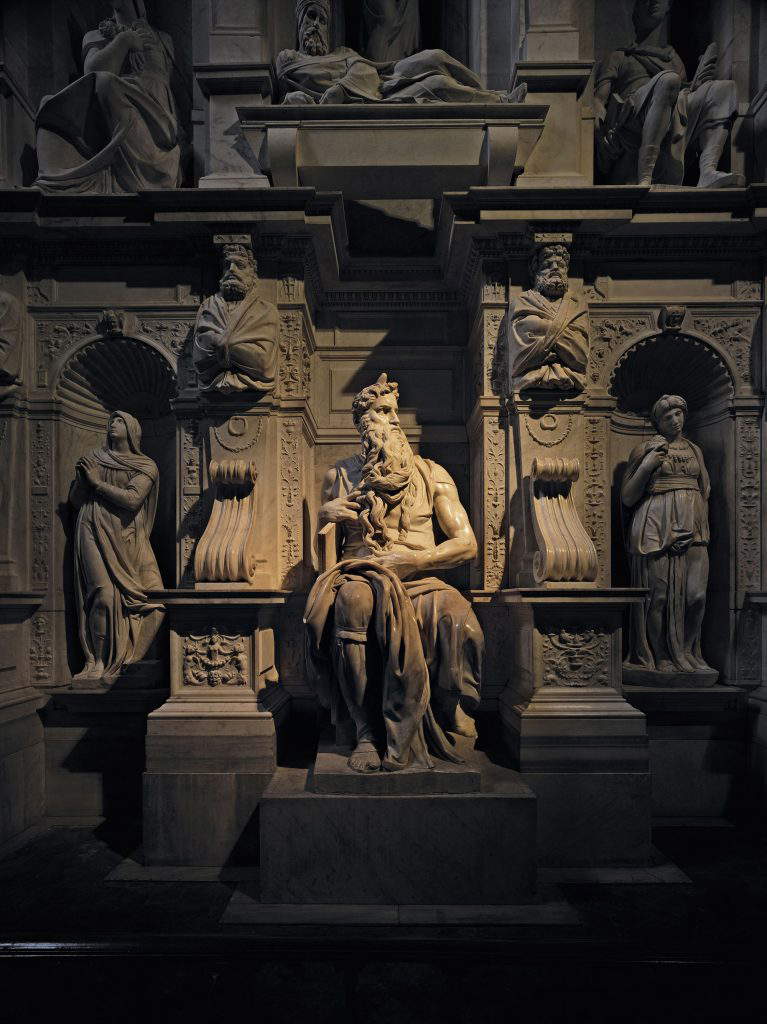 |
| Moses illuminated by Mario Nanni |
Thus, some features of the statue are reinterpreted by Forcellino in light of the later intervention, and the scarcity of marble that the artist would have had to deal with in the left area, going to rework it to make the changes.
For example, the restorer observes a certain stiffness in the left side of the neck, as opposed to the other side, and explains it by the impossibility of having the shoulder, already set, perform the same torsion as well, and by the lack of material.
According to Forcellino, moreover, the statue originally had not only a frontal gaze, but also the two feet together; therefore, the artist would have intervened in the lower area as well, bending one leg in search of a more complex internal spatiality of the sculpture. And the depth of the bending of that leg, which makes the movement so powerful, should be read as a consequence of the fact that in the left area of the already sculpted marble block, it would not have been possible to find space for the new foot to be made, except in a very backward position.
Even the obvious dimensional difference between the two knees, treated by Michelangelo with the addition of a crease running through the robe above the smaller left knee, and “distracting” the viewer, would derive from the limitations of the block already ahead in the carving.
Similarly, the course of the much-debated and admired beard, dragged to the right by the index finger, is argued: it would have been designed in this way to cope with the shortage of marble. On the left, in fact, where the thick mass should end following the turning of the head, we see a single lock, moreover very crushed, because the marble would have already been worked down to the robe.
It would remain to be explained, however, why Michelangelo decided to return to his work more than twenty years later and modify it so radically. Whether he really wanted to recall, through that turning of the head, the moment when the gaze of the Jewish leader rests on his people intent on worshipping the idol?
Forcellino and later also the art historian Cristoph L. Frommel hypothesized that the sculptor, by turning the head of his Moses, had intended to ensure that the statue’s gaze would no longer rest on the altar containing the chains with which, according to tradition, St. Peter was imprisoned (the “bonds” from which the church’s name derives), alleged relics, the veneration of which Michelangelo would have considered mere religious superstition.
The restorer then notes that with such a twist the statue was also able to intercept the light from the window on the left that illuminated its face, a particularly significant fact if one takes into account that the two conspicuous horns on its head stand for the very rays of divine illumination. The window in question was unfortunately closed later, but thanks to light-designer Mario Nanni, who in 2017 devised a special LED lighting system diversified for four times, it was possible to recover, on the precious marbles, the original effect of the natural light of the various phases of the day (dawn, noon, dusk, twilight).
Moreover, the posture we see today certainly allowed the statue to gain in strength and liveliness compared to a hypothetical initial frontal arrangement.
In conclusion, Michelangelo materialized a powerful and ambiguous presence, and it is precisely the accuracy of the analysis of the effects generated by its disturbingly dense vitality on the observer that still constitutes, beyond the outcomes of subsequent studies, the most significant merit of Sigmund Freud’s contribution.
In 1545, the decades-long affair of the papal burial came to a conclusion; the tomb lacked the grandeur and decorative richness that should have characterized it, and yet it still constitutes a fundamental moment in the production of the great Tuscan artist and, more generally, in the context of Renaissance art, especially by virtue of the vigorous sculptural depiction of the legislator of the people of Israel.
Warning: the translation into English of the original Italian article was created using automatic tools. We undertake to review all articles, but we do not guarantee the total absence of inaccuracies in the translation due to the program. You can find the original by clicking on the ITA button. If you find any mistake,please contact us.